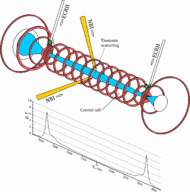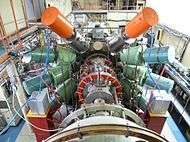Gas Dynamic Trap
The Gas Dynamic Trap is a magnetic mirror machine being operated at the Budker Institute of Nuclear Physics in Akademgorodok, Russia.
Technical Specifications
Dimensions The plasma inside the machine fills a cylinder of space, 7 meters long and 28 centimeters in diameter.[1] The magnetic field varies along this tube. In the center the field is low; reaching (at most) 0.35 Teslas. The field rises to as high as 15 Teslas at the ends.[1] This change in the strength is needed to reflect the particles and get them internally trapped (see: the magnetic mirror effect).
Heating The plasma is heated using two methods, simultaneously. The first is neutral beam injection, where a hot (25 KeV), neutral beam of material is shot into the machine at a rate of 5 megawatts.[1] The second is Electron Cyclotron Resonance Heating which is where electromagnetic waves are used to heat a plasma, analogous to microwaving it.
Performance As of 2016, the machine had achieved a plasma trapping beta of 0.6 for 5E-3 seconds (or 5 milliseconds).[2] It had reached an electron temperature of 1 KeV using the method of Electron cyclotron resonance heating. It had reached an ion density of 1E20 Ions/Meter^3.[1] The machine loses material out of the ends of the mirror [3] but material is replenished at such a rate as to maintain a density inside the machine.[3]
Diagnostics
During any given experiment, operators can choose from at least 15 fusion diagnostics to measure the machines' behavior:[2]
- Thomson Scattering
- Motional Stark Effect
- CX Energy Analysis (2)
- Rutherford Ion Scattering
- Ion End Loss Analyzer
- Microwave Interferometer
- Dispersion Interferometer
- Diamagnetic Loops
- Langmuir Probes
- Pyro electric Detectors
- RF Probes
- Beam Dump Calorimeters
- NBI Sec. Electron Detectors
- Neutron Detectors
- Thermonuclear Proton Detectors
Pictures of the GDT
 The structure of the Gas Dynamic Trap, showing the magnets (in red) and two methods of heating the plasma (Neutral beam injection) and (Electron Cyclotron Resonance Heating). Also shown is the magnetic field profile across the machine.[4]
The structure of the Gas Dynamic Trap, showing the magnets (in red) and two methods of heating the plasma (Neutral beam injection) and (Electron Cyclotron Resonance Heating). Also shown is the magnetic field profile across the machine.[4] The Gas Dynamic Trap as seen from above.
The Gas Dynamic Trap as seen from above. The location of the Diagnostics used to measure the behavior of the GDT.
The location of the Diagnostics used to measure the behavior of the GDT.
References
- 1 2 3 4 "Three Game Changing Discoveries: A Simpler Fusion Concept?" by Thomas C Simonen, Journal of Fusion Energy, 2016
- 1 2 Gas Dynamic Trap (GDT). Experiments with Electron Heating. Budker Institute of Nuclear Physics, Novosibirsk State University. Siberian Branch, Russia, 2012, Thomas Simonen
- 1 2 "Gas-dynamic trap: an overview of the concept and experimental results", A A Ivanov and V V Prikhodko, 2013 Plasma Phys. Control. Fusion 55 (2013) 063001 (31pp)
- ↑ P.A. Bagryansky et. al., Physical Review Letters 114, 205001 (2015)